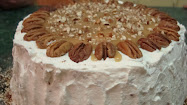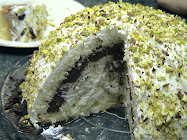 I grew up in a household where my mother baked bread every Saturday. As a teenager I was eager to learn the technique of kneading a yeast dough and with my mother's skilled experience on the one hand and a drawerful of recipe books on the other-Fleischman's Yeast being a favorite-I soon learned the art of bread making. Unlike my mother who had the responsibility of feeding a large family, my bread baking has nearly always been recreational. But one summer I, together with three other women, ambitiously decided to fill a table with our baking at the local Thursday farmer's market. We worked hard. Hilda baked dozens of the softest white buns imaginable, wild rice bread and granola. Phyllis boiled up several batches of bagels in addition to baking herbed bread. Frances made scones, French bread and also contributed cut flowers from her perennial garden. I baked rye bread, whole wheat bread and cinnamon bread along with apple and peach pies. I also sold bundles of dill, parsley, summer savory and sorrel. Several times that summer I heaved and hauled home heavy 20 kilo sacks of organic flour from Tall Grass Prairie Bread Company in Winnipeg. The coarse stone-ground texture and freshness of their milled-daily, prairie-grown, hard spring cadillac wheat flour resulted in loaves of bread where each crunch-filled bite had an intense aromatic flavor. (That's why I stubbornly carry back with me to Toronto Tall Grass Prairie's flour; the bread I have baked using organic flour from several mills in Ontario has never yet been as good as the loaves I made for the farmer's market that summer.)
I grew up in a household where my mother baked bread every Saturday. As a teenager I was eager to learn the technique of kneading a yeast dough and with my mother's skilled experience on the one hand and a drawerful of recipe books on the other-Fleischman's Yeast being a favorite-I soon learned the art of bread making. Unlike my mother who had the responsibility of feeding a large family, my bread baking has nearly always been recreational. But one summer I, together with three other women, ambitiously decided to fill a table with our baking at the local Thursday farmer's market. We worked hard. Hilda baked dozens of the softest white buns imaginable, wild rice bread and granola. Phyllis boiled up several batches of bagels in addition to baking herbed bread. Frances made scones, French bread and also contributed cut flowers from her perennial garden. I baked rye bread, whole wheat bread and cinnamon bread along with apple and peach pies. I also sold bundles of dill, parsley, summer savory and sorrel. Several times that summer I heaved and hauled home heavy 20 kilo sacks of organic flour from Tall Grass Prairie Bread Company in Winnipeg. The coarse stone-ground texture and freshness of their milled-daily, prairie-grown, hard spring cadillac wheat flour resulted in loaves of bread where each crunch-filled bite had an intense aromatic flavor. (That's why I stubbornly carry back with me to Toronto Tall Grass Prairie's flour; the bread I have baked using organic flour from several mills in Ontario has never yet been as good as the loaves I made for the farmer's market that summer.)I don't know how the other women organized their baking, but I worked out a routine that filled every minute of my Thursday. My work actually began earlier in the week on Monday or Tuesday when I made pies and then froze them. Wednesday evening I mixed the whole wheat dough and the rye dough and set them in the fridge to rise overnight. Too early Thursday morning I removed all the pies from the freezer and the doughs from the fridge. I then kneaded the dough for the cinnamon bread by which time the whole wheat and rye doughs were ready to be shaped and put on the pans. They baked while the cinnamon bread continued proofing. When the whole wheat and rye loaves were baked and cooling on the rack, the cinnamon breads went into the oven. Next into the oven were the pies. All my baking had to be completed by 2 p.m. as I still had an hour's commute to my herb garden where the herbs had to be cut, cleaned and bundled and then onto the farmer's market. Here the table had to be set up and all the baking arranged, last minute bagging and pricing to attend to. At 4 o'clock, exhausted by the many hours of work behind me, I sat down to wait for the customers. They always came. What satisfaction I derived from the man who returned a second week to buy another peach pie even though he was the only family member who liked peach pie. I even enjoyed the woman who haggled for a 50 cent discount on her bread. In spite of the frazzled worry of coordinating rising doughs with limited oven space and the headache and tired shoulders that a Thursday inevitably brought on, I enjoyed that summer of baking and selling. I have to admit though that my first batch of rye bread was a complete failure. The loaves were hard and dry, flat as a pancake. I consoled myself with the fact that rye flour, in particular stone ground rye flour, is difficult to work with. Fortunately I learned quickly and by the second week I placed my anise rye loaves with their orange butter glaze proudly alongside my other breads.
For three months that summer we were part of a parking lot of vendors: an apiarist with that creamy-smooth sweet clover honey that only Manitoba bees can produce, several vegetable farmers, some craft tables, a Winnipeg bakery sold its bread and rolls, one family filled a table with home canning. The farmer's market was small and had only been in operation a few years when we joined. It had less than twenty vendors if I remember correctly but it was the beginning of a burgeoning farmer's market that has now grown to more than forty vendors selling strawberries, raspberries and corn in season, free-range chickens, home made egg noodles, sausages, vegetables, baked goods, where-else-than-in-Manitoba Icelandic baking and much more. Our table of baked goods is undoubtedly long forgotten in the collective memory of the community (if it was ever there to begin with) but I am pleased that I could contribute in some way to the ongoing vitality of that local farmer's market.
But I have not yet mentioned the LTD Ford station wagon-the dark blue one-have I? It pulled onto the pavement about the same time I did. Like my vehicle, it too was loaded with bread. That is where the similarity ended! Unloading the back of their station wagon the vendors began stuffing their many-tiered metal rack with dozens and dozens of loaves of bread, a seemingly endless supply of straight-from-the-freezer, uprightly uniform, square bread machine loaves, many of them burned on top. My jaw dropped the first time I saw the rack of burned bread. I was outraged when the station wagon returned the second week. I sputtered in disbelief the third week the vendors set up their rack. By the fourth week I was speechless. They sold cheap and fast (no wonder our 50 cent cheapskate expected a discount!) and in spite of all my inward rantings and ravings they were always the first to sell out. With their rack emptied of the last loaf they packed up and headed home, supposedly to begin their fill-the-freezer regime for next week's market.
I had been baking bread for many years by that summer and eventually a sense of calmed reason tempered my outrage. Had my hands not learned to enjoy the perfect smoothness of a soft white dough, could they not manage a delicately sticky rye dough? Were they not able to recognize when the tired ache of kneading had paid off and it was time to proof the dough? Had they not gently indented countless doughs testing for springiness and then knocked them back for further rising? Were they not able to lift a dough out of its kneading bowl to pinch, press or roll into a loaf? Was there not an organic symbiosis between my hands and the doughs I had kneaded, a bread intuition that reached back through my mother and my grandmother that no amount of "measure the flour-flick a switch-sit back and wait" bread machine bread could rival? With hands like mine, why fret? Why not just sit back, watch the flurry of activity across the parking lot and smugly, knowingly smile?















































No comments:
Post a Comment